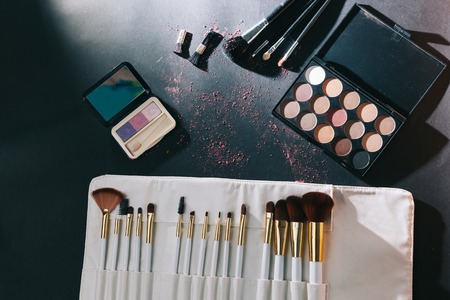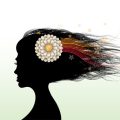Origins of Eyeshadow in Ancient Cultures
When we swipe on our favorite eyeshadow today, it’s easy to forget that this beauty ritual has roots stretching back thousands of years. The story of eyeshadow begins with some of the world’s earliest civilizations—namely Ancient Egypt, Mesopotamia, and Greece—where people used natural pigments not just for beauty, but for cultural, spiritual, and even practical reasons.
In Ancient Egypt, eye makeup was a daily essential for men and women alike. Egyptians famously used kohl—a mixture of galena (a lead-based mineral) and other ingredients—to line their eyes. But beyond the dramatic look, kohl was believed to protect against the harsh desert sun and ward off evil spirits. Green malachite powder was also used to add color to the eyelids, symbolizing health and rebirth. Even children wore these pigments as a form of protection!
Meanwhile, in Mesopotamia, people turned to crushed gemstones and naturally colored clays to decorate their eyes. These early beauty enthusiasts weren’t just following trends—they believed these colors could invoke divine favor or signal social status. Applying eye pigments became part of both everyday grooming and sacred rituals.
Jumping over to Ancient Greece, we see the influence of both Egyptian and Mesopotamian traditions. Greeks used powders made from minerals like ochre and charcoal to highlight their eyes, often mixing them with olive oil for easier application. For Greek society, enhancing one’s eyes was seen as a way to express individuality and allure, showing that even then, makeup was about more than just looks.
All in all, the origins of eyeshadow are deeply intertwined with ancient beliefs about beauty, spirituality, and self-expression. From sacred rituals to daily life hacks against the elements, these early uses set the stage for everything we love about eyeshadow today—and prove that the urge to play with color is truly timeless.
2. Eyeshadow Through the Ages: The Middle Ages to Early 20th Century
As we journey from ancient Egypt and Greece into later eras, the use and perception of eyeshadow in Western culture changed dramatically. In Medieval Europe, beauty standards took a sharp turn. Instead of vibrant pigments, people favored a more natural look. Pale skin was prized as a symbol of nobility, so makeup—including eyeshadow—was often avoided, as it was associated with vanity or even sinfulness. Women occasionally used subtle herbal tints to enhance their features, but anything too obvious was frowned upon.
The Victorian era (1837–1901) marked another shift in beauty ideals. Under Queen Victoria’s influence, modesty and natural beauty became the gold standard. Most women steered clear of bold makeup, especially on the eyes. However, discreet homemade concoctions—like soot mixed with oil—were sometimes used to darken lashes and brows for special occasions. Eyeshadow remained mostly out of sight in mainstream society, relegated to stage performers or women on the fringes.
The Roaring 1920s: A Beauty Revolution
The early 20th century brought dramatic change! The 1920s flapper era embraced bolder looks inspired by Hollywood films and Jazz Age glamour. Suddenly, smokey eyes became all the rage. Commercially produced eyeshadows hit drugstore shelves in tins and compacts. Women flocked to recreate the sultry looks seen on silver screen icons like Clara Bow and Louise Brooks.
How Eyeshadow Was Perceived Across Eras
| Era | Beauty Trend | Eyeshadow Usage |
|---|---|---|
| Medieval Europe | Pale, natural look | Rarely used; subtle tints if any |
| Victorian Era | Modesty, natural beauty | Mainly avoided; some homemade recipes for special events |
| 1920s (Flappers) | Bold, dramatic makeup | Widely embraced; commercial products available |
Cultural Shifts Set the Stage for Modern Trends
This timeline shows how societal values deeply influenced whether eyeshadow was hidden or flaunted. By the 1920s, changing attitudes toward women’s independence and self-expression paved the way for eyeshadow to become a staple in American beauty routines—a trend that would only grow stronger in the decades ahead.
![]()
3. Hollywood Glam and the Golden Age of Eyeshadow
When we think about eyeshadow in American pop culture, it’s impossible not to picture the dazzling glamour of classic Hollywood. The mid-20th century, often called the “Golden Age” of film, transformed beauty standards across the United States—and eyeshadow played a starring role. Legendary actresses like Marilyn Monroe, Elizabeth Taylor, and Audrey Hepburn became global style icons, each with her own signature eye look that millions tried to emulate. Bold cat-eyes, shimmering lids, and perfectly blended smoky shadows lit up the silver screen and set new trends for everyday women.
During this era, makeup artists in Hollywood studios developed innovative techniques to ensure actresses’ eyes popped under bright stage lights and in black-and-white or Technicolor films. Dramatic contouring using deep browns, navy blues, and silvery hues added depth and allure. False lashes and winged eyeliner paired with colorful shadow made eyes appear larger than life—a must for close-ups on camera. These bold looks weren’t just for celebrities; as movies became a central part of American entertainment, ordinary women eagerly adopted these styles at home.
The influence of Hollywood on beauty routines was so strong that major cosmetic brands started releasing eye makeup inspired by famous actresses. Department stores showcased palettes promising “starlet eyes,” and women practiced their blending skills in front of bedroom mirrors. The classic glamour of old Hollywood didn’t just make eyeshadow popular—it made it an essential tool for self-expression and confidence, forever cementing its place in American beauty culture.
4. Counterculture, Disco, and the Color Explosion of the 1960s-80s
If you’ve ever wondered how eyeshadow went from subtle enhancement to a full-on canvas for self-expression, look no further than the dynamic decades between the 1960s and 1980s. This period was a wild ride for beauty—and especially for eyeshadow—thanks to huge cultural revolutions, disco fever, and the rise of bold subcultures.
The Counterculture Movement and Eyeshadow Freedom
The 1960s were a time of rebellion and breaking away from traditional norms. Young people wanted to express their individuality, and makeup became one of their favorite tools. Eyeshadow palettes exploded with color: think bright blues, greens, purples, and even shocking pastels. It wasn’t just about looking pretty; it was about making a statement.
Disco Fever: Glitter, Glam, and Going Bold
By the 1970s, disco had taken over American nightlife. The dance floor called for drama—and makeup answered. Eyeshadow looks became more experimental and dazzling than ever before, with metallics, shimmer finishes, and even glitter taking center stage under the mirrored ball. For many, Studio 54 wasn’t just a club—it was a runway for personal style.
Subcultures Pushing Boundaries in the 1980s
The 1980s took everything up another notch. Punk rockers, New Wave fans, and pop icons like Madonna inspired people to go bold or go home. Neon shades, electric blues, hot pinks—there were no limits. This era truly celebrated “more is more” when it came to eyeshadow application and color choices.
| Decade | Popular Eyeshadow Trends | Cultural Influence |
|---|---|---|
| 1960s | Pastels, cut crease looks | Counterculture & Youth Rebellion |
| 1970s | Metallics, glittery finishes | Disco & Nightlife Glamour |
| 1980s | Neons, bold multi-color blends | Punk/New Wave Subcultures & Pop Stars |
This colorful explosion in eyeshadow trends not only brought vibrancy to American beauty routines but also set the stage for today’s creative experimentation. Whether you’re channeling Twiggy’s mod look or Madonna’s unapologetic glam, these decades proved that your eyelids could be your most expressive accessory!
5. The Rise of the Beauty Industry and Eyeshadow Innovation
The early 20th century marked a turning point for eyeshadow in America, thanks to the explosive growth of the beauty industry. With the invention of mass production techniques, companies like Max Factor and Maybelline began producing eyeshadows that were affordable and accessible to everyday people—not just Hollywood stars or the social elite. This democratization of makeup made it possible for nearly anyone to experiment with color and style.
Mass Production: Making Eyeshadow Mainstream
Before mass production, cosmetics were often handmade or imported, making them expensive and difficult to find. With factories churning out pressed powders and cream formulas by the thousands, eyeshadow became a staple item in drugstores coast-to-coast. Suddenly, women from all walks of life could pick up a palette during their regular shopping trips.
The Power of Advertising
As competition heated up, brands turned to creative advertising strategies to win over customers. Magazines and radio commercials promised glamour, confidence, and modernity in every compact. Campaigns featured iconic celebrities like Elizabeth Taylor and Audrey Hepburn wearing bold eye looks—setting trends that everyday Americans were eager to follow. Slogans like “Every Woman Can Be Beautiful” resonated with a new generation that saw makeup as both self-expression and empowerment.
Eyeshadow Gets a Makeover: New Formulations & Shades
Innovation didn’t stop at packaging or advertising. Cosmetic chemists worked tirelessly to create new formulations—think smoother powders, longer-lasting creams, and blendable sticks—that were easy to apply and safe for sensitive skin. The post-war era brought a rainbow of shades, from pastel blues in the ‘50s to psychedelic neons in the ‘60s, reflecting changing fashion trends and cultural moods.
Eyeshadow for Everyone
By the late 20th century, eyeshadow was no longer reserved for special occasions or movie sets—it was an everyday essential found in nearly every American makeup bag. Whether you shopped at the local drugstore or splurged at a department store counter, there was an eyeshadow product (and shade!) for every taste, skin tone, and budget. Thanks to mass production, savvy marketing, and constant innovation, eyeshadow truly became a symbol of American beauty culture.
6. Modern Trends: Diversity, Social Media, and Self-Expression
Today, eyeshadow has truly become a canvas for self-expression, thanks to the powerful influence of social media and a new emphasis on diversity in the beauty industry. Unlike in previous decades, modern eyeshadow trends celebrate all skin tones, eye shapes, and personal styles. Brands now create vast color ranges and inclusive shade palettes to ensure everyone can find their perfect match. Platforms like Instagram, YouTube, and TikTok have turned everyday users into trendsetters. Influencers and makeup artists post tutorials, reviews, and creative looks that inspire millions daily. Viral challenges—like the “rainbow eyeshadow” or “cut crease”—showcase endless creativity and encourage followers to try bold new styles at home. These platforms also provide spaces for marginalized voices, leading to greater representation and more innovative ideas in makeup artistry. Whether you love natural neutrals or neon pigments, there’s room for every kind of expression in today’s eyeshadow community. The modern era is about breaking rules, having fun with colors, and celebrating what makes each person unique.


